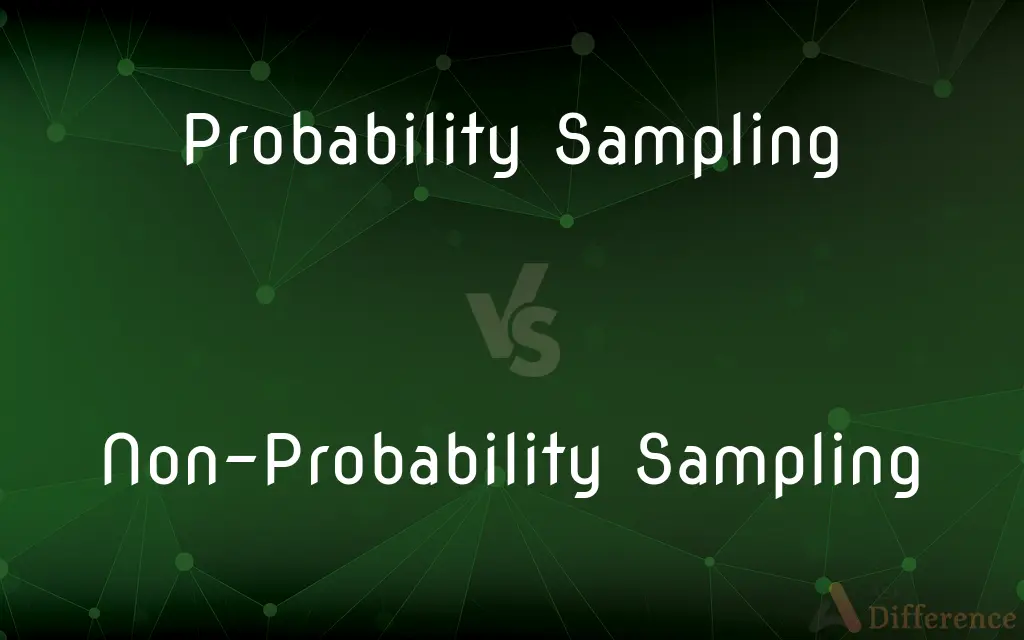Probability Sampling vs. Non-Probability Sampling — What's the Difference?
By Tayyaba Rehman — Published on November 10, 2023
Probability Sampling allows every member of the population an equal chance of selection, while Non-Probability Sampling doesn't guarantee equal selection chances.

Difference Between Probability Sampling and Non-Probability Sampling
Table of Contents
ADVERTISEMENT
Key Differences
Probability Sampling and Non-Probability Sampling are two fundamental methodologies in statistics for selecting a subset from a larger population. Probability Sampling ensures that every member of the target population has a known, non-zero chance of being selected in the sample. This method is grounded in the principles of randomness, ensuring representation, which is essential for making statistical inferences about the whole population.
Conversely, Non-Probability Sampling doesn't provide all members of the population an equal or known chance of being included in the sample. This method's selection is often based on other criteria, not strictly randomness. The choice might be based on convenience, judgment, or specific criteria rather than random chance.
While Probability Sampling often relies on techniques like random sampling, stratified sampling, or cluster sampling, Non-Probability Sampling employs methods such as convenience sampling, judgmental sampling, or quota sampling. The distinction between these two is vital because the type of sampling method can significantly impact the generalizability and validity of research findings.
Probability Sampling typically leads to more accurate and generalizable results due to its inherent randomness. In contrast, Non-Probability Sampling might introduce biases, making it less reliable for generalizing results to the broader population. However, Non-Probability Sampling can be useful in exploratory research, where generalization is not the primary objective.
In summary, while Probability Sampling offers a random and representative slice of the entire population, Non-Probability Sampling might not always capture the diversity and nuances of the target group. The choice between these methods depends on the research objectives and the desired accuracy.
ADVERTISEMENT
Comparison Chart
Basis of Selection
Randomness.
Convenience, judgment, or specific criteria.
Generalizability
High (results can be generalized to the entire population).
Low (results may not represent the entire population).
Bias Potential
Low.
High.
Examples of Methods
Random sampling, stratified sampling.
Convenience sampling, judgmental sampling.
Purpose
Statistical inferences about the whole population.
Exploratory research, specific cases or initial insights.
Compare with Definitions
Probability Sampling
Systematic method aiming for equal representation of the population.
Through Probability Sampling, the survey accurately depicted the city's views.
Non-Probability Sampling
Selection based on subjective factors rather than randomness.
Their Non-Probability Sampling targeted only long-term residents of the town.
Probability Sampling
An approach that selects a subset based on specific random criteria.
Probability Sampling gave each city resident an equal chance to be surveyed.
Non-Probability Sampling
An approach where not all population members have a known chance of selection.
Using Non-Probability Sampling, the team picked participants based on availability.
Probability Sampling
A method allowing statistical generalizations about the larger population.
Researchers prefer Probability Sampling when needing to infer population parameters.
Non-Probability Sampling
A sampling method where individuals are selected based on non-random criteria.
Jake's convenience-based survey was an example of Non-Probability Sampling.
Probability Sampling
A technique grounded in randomness to represent the population.
Probability Sampling reduces the chances of sampling error.
Non-Probability Sampling
A technique that might not provide equal representation of the population.
Due to its Non-Probability Sampling nature, the results couldn't be generalized to everyone.
Probability Sampling
A sampling method where every individual has a known, non-zero chance of selection.
For her study, Clara used Probability Sampling to ensure unbiased results.
Non-Probability Sampling
A method often used for exploratory or preliminary research.
For initial insights, the marketers relied on Non-Probability Sampling.
Common Curiosities
Can results from Non-Probability Sampling be generalized to the entire population?
Typically, no. Due to potential biases, its results may not represent the entire population.
Can Non-Probability Sampling introduce biases?
Yes, since it doesn't guarantee equal representation of the population.
Is Probability Sampling always better than Non-Probability Sampling?
Not always. The choice depends on the research objective. Probability Sampling is preferred for generalizable results.
What's the primary difference between Probability and Non-Probability Sampling?
Probability Sampling gives each population member a known chance of selection, whereas Non-Probability Sampling doesn't.
Can quota sampling be categorized under Non-Probability Sampling?
Yes, quota sampling is a type of Non-Probability Sampling.
Is stratified sampling a form of Probability Sampling?
Yes, stratified sampling is a type of Probability Sampling.
Why might researchers opt for Non-Probability Sampling?
It might be more convenient, cheaper, or suitable for specific or exploratory studies.
Does Probability Sampling ensure 100% unbiased results?
While it reduces bias, no sampling method can guarantee entirely unbiased results.
Are results from Probability Sampling always accurate?
They're more likely to be accurate and representative, but errors can still occur.
What's a common Non-Probability Sampling method?
Convenience sampling is a frequently used Non-Probability Sampling method.
Share Your Discovery

Previous Comparison
Chronic Hunger vs. Seasonal Hunger
Next Comparison
Reciprocating Pump vs. Rotary PumpAuthor Spotlight
Written by
Tayyaba RehmanTayyaba Rehman is a distinguished writer, currently serving as a primary contributor to askdifference.com. As a researcher in semantics and etymology, Tayyaba's passion for the complexity of languages and their distinctions has found a perfect home on the platform. Tayyaba delves into the intricacies of language, distinguishing between commonly confused words and phrases, thereby providing clarity for readers worldwide.












































